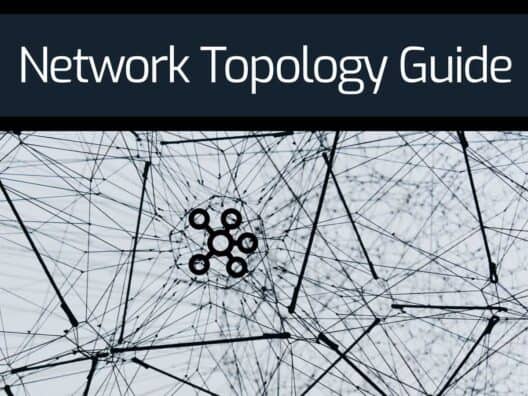In this tech-driven world, networking plays a crucial role in every organization. It is a medium that helps share information and resources between different computer systems and network devices. It acts as the basis of communication between two nodes or devices and contributes to smooth organizational functioning. However, this whole process is not easy as it sounds. The complete process of building a network and arrangement of networking devices is a daunting task. Organizations need to configure a map that helps them achieve optimal network performance, right from planning out a specific model to creating a physical and logical network layout they need to cover all.
Numerous topology tools can help configure the layout of a computer network. Further, it may help detect any issue or troubleshoot errors.
What is Network Topology?
Network topology is the physical and logical layout of the network in which various nodes, devices, and connections are arranged to relate to each other. There are many methods to align a network setup, and each one has its pros and cons.
To run a digital business, every organization needs a reliable Internet connection and a high-performing network. To choose the best network topology, administrators recommend one must account for the size and scale of the business, its budget, and goals.
Further in this post, we will discuss how implementing a network topology for your organization plays a crucial role and its types.
Importance of Network Topology
In simple language, network topology helps us figure out the arrangement of different network elements and where they connect. Secondly, it helps us understand how the various nodes and devices interact with one another and how they are beneficial for our everyday use.
Understanding a network topology helps us map the layout of the network both physically and logically. Before we talk about the different topologies and how they are beneficial for your organization, let's understand the physical and logical network layout.
Physical network layout is more about the setup and maintenance of physical connections of the devices, including wires, cables, and more in a computer network. On the other hand, logical network layout is a conceptual representation of how these devices operate and transmit data at different layers of abstraction in the computer system.
Choosing the suitable topology will help reduce cost, resource distribution across the network, and troubleshoot errors. Have a look at the advantages of network topology.
Advantages of Network Topology
- Network Health Diagnostics Instead of manually keeping an account of all devices on a network, having a clear roadmap will help ease the discovery of all devices. For example, you experience packet loss from point A to D. Now, which point is causing the trouble will be hard to identify if you do not have a roadmap. Also, utilizing these tools will help monitor your network, scan any changes made in the inventory or on network maps.
- Troubleshoot Errors An issue in the network can shut down your productivity and damage your goodwill. Thus, have a more efficient topology for your business that will quickly help detect and fix the disruptions in the network. In addition, it becomes easier for an IT team to locate the issue and facilitate quick troubleshooting with a detailed network roadmap.
- Helps Improve Efficiency Building a multiple network map for your organization will help increase operational efficiencies and reduce network delays. It is essential to choose the correct topology depending on the size and scale of your business to maintain network efficiency.
- Smooth Communication Process With the execution of the correct topology, communication gets smooth. It becomes much better to keep an account of the cause and effect of failure. IT teams find it easy to detect the fault and troubleshoot errors with minimal downtime.
- Cost Reduction If you don’t have a roadmap, you will need to invest more time and money in finding the fault and fixing the error. Having a network roadmap will help you add or remove elements from your work cycle in a more convenient way. Thus, you will have to spend less money on outsiders to fix the fault.
Main Types of Network Topologies
There are various types of network topology, each designed with a purpose. There is no specific design that fits all organizations. Thus, finding the right one for smooth operational functioning is crucial for your business. We have penned down some of the most common types of topologies with their significance and drawbacks. Get a brief overview of each type before you conclude.
1. Star Topology
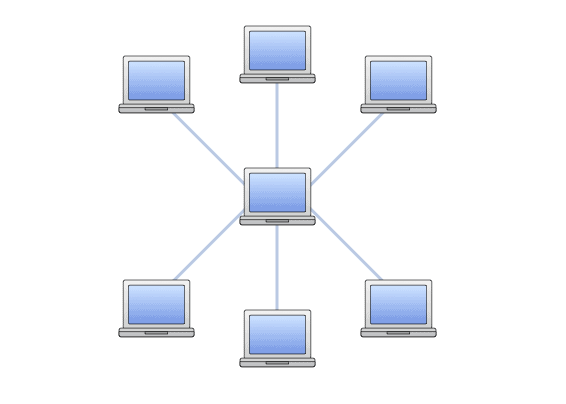
Star topology is known to be one of the most commonly used network configurations creating a star-like shape. Each node in this framework has an independent connection to the central hub (responsible for managing the data transmission process) through coaxial cable, optical fiber, or twisted pair cable. In this type of topology, the central hub acts as a server and passes the information received from one node to another. All the data must travel through the central node, which further helps prevent data loss. Also, there is no interconnection between the nodes, which means if the attacker tries to damage any single node, the network system will continue to work. This form of topology can be practiced at bank networks.
Further, adding any new device is easy with star topology as there will be no disruption in the network, and only the central device will have to be updated.
Advantages of Star Topology:
- It has a stable and secure network layout
- Easy to set up and manage wires
- You can add, remove or modify devices to the network without any disruption
- Easy to detect faults and identify errors
- Minimum chance of network failure and data loss
- Any failure in a single node doesn’t impact others in the network
- Centralization system helps detect any suspicious behavior
Disadvantages of Star Topology:
- Expensive to install
- Additional hardware (hub or switch) is necessary that adds to cost
- Failure in the central device may disable the attached nodes. Thus, no network connection
- Network performance solely depends on the central device’s configurations, speed, and performance
- The administrator needs to properly monitor and maintain the central hub to avoid any network issues
2. Bus Topology

Under Bus Topology, the administrators directly connect all the nodes or devices to a single half-duplex cable referred to as a bus. This bus or single wire has two end terminals. When a device passes the broadcast message into the wire, other devices can see, but only the intended recipient can accept and process the message. This kind of network topology is also known as line or backbone topology. Damage to the backbone wire and the entire network shuts down. Also, this topology requires less amount of cabling and works well for smaller networks.
Advantages of Bus Topology:
- It has a simple layout and works best for smaller networks
- Easy to connect and remove devices without causing any disturbance in the network
- Need less cable length in comparison to the star topology
- Cost-effective
- One can add more nodes to the network by joining additional cables
Disadvantages of Bus Topology:
- A single wire performs the task of data transmission, which may lead to various issues in the future
- A fault in the main cable may shut your entire network. It will also make it difficult to detect the error
- Simultaneous data transmission in opposite directions is not possible. Therefore, this type of topology is not suitable for organizations that practice high-level data transmission regularly
- Time-consuming and expensive to restore if the entire network shuts down
3. Ring Topology
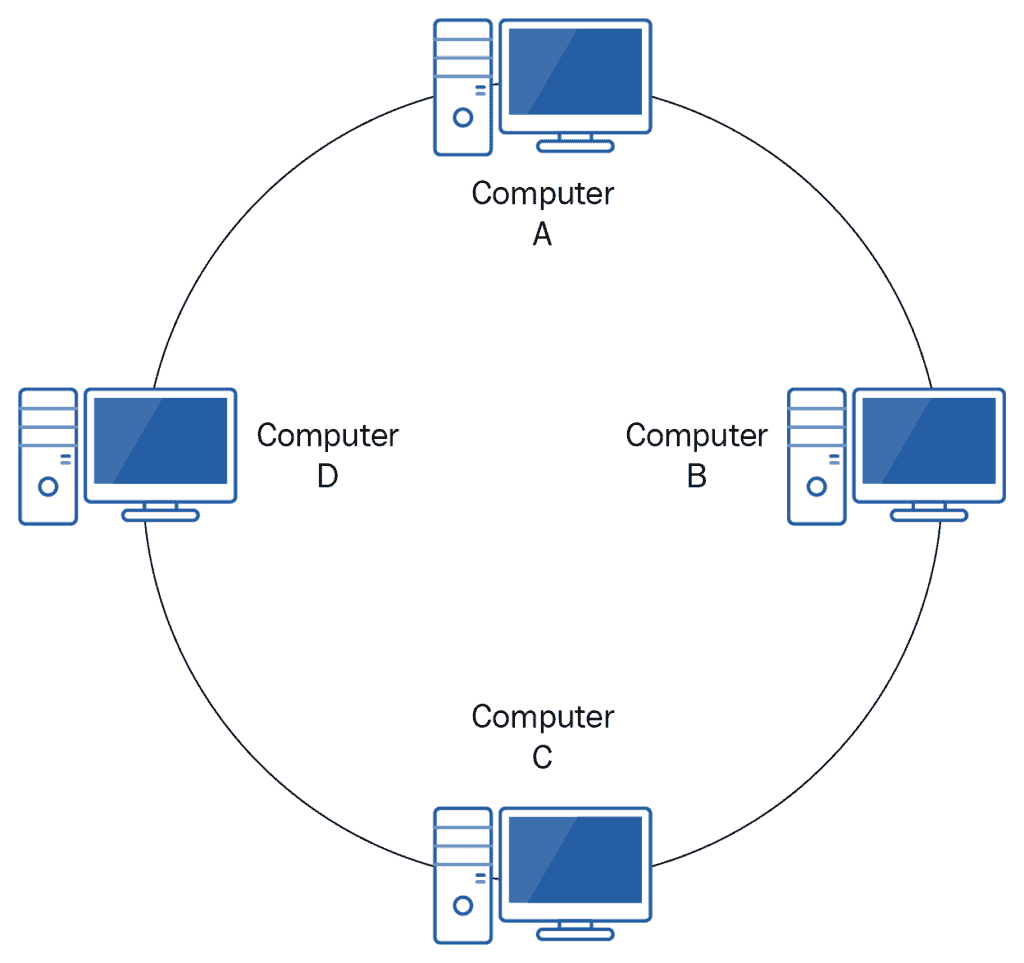
Ring Topology follows a token-passing principle forming a ring of connected devices with two neighbors on each side for better transmission. Here, the data packets move in a loop to reach their destination forming a ring. Thus, each node has an equal chance to transmit data in this topology. Also, under this type, the ring can send data at any given time. Single and Dual are the two types of Ring Topologies. Single ring topology is a half-duplex, whereas dual ring topology is a full-duplex and can transfer data in both directions – clockwise and anticlockwise.
Advantages of Ring Topology:
- Minimum chances of packet collision due to the token system
- High-speed networking
- One of the cost-effective topologies
- Data transmission is possible in both directions with fewer errors in Dual Ring Topology
- Inexpensive to install
- Point-to-point nodes connectivity makes it easier for admins to identify faults or errors
Advantages of Ring Topology:
- Failure in a single node may impact the entire network
- Continuous monitoring of the nodes is essential
- The addition or removal of a new device may lead to communication delays
- Limited Bandwidth
- Transmission line failure is possible
4. Tree Topology
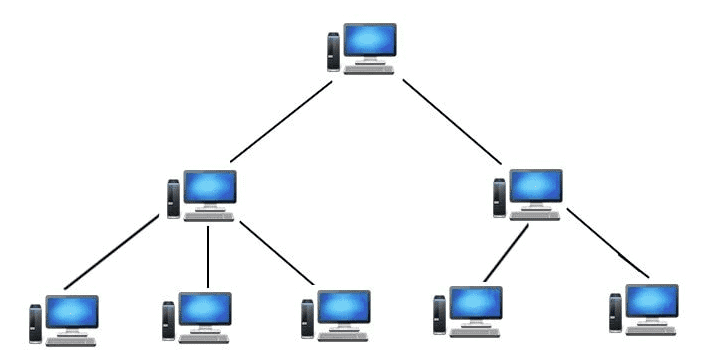
Tree Topology has a different structure where connected devices are arranged like the branches of a tree. This type of topology is a combination of star and bus topology. It also follows a parent-child hierarchy in which a root node or the central unit connects and passes the data to the other nodes or branches. Simply put, there are hub devices connected, and each hub device has its connected nodes. This form of topology is best for organizations looking forward to a Wide area network. Also, it is easy to detect a fault in the nodes, but if the hub fails, the entire network will shut down.
Advantages of Tree Topology:
- Easier to add more nodes
- Identification and Troubleshooting are easier
- Reduce chances of data loss
- Each segment has its point-to-point wiring
- Have better flexibility and scalability
Disadvantages of Tree Topology:
- Failure in the root node will affect all the connected branch nodes
- Expensive to manage as more cabling is needed to connect the devices
- Network maintenance is challenging under tree topology
- If there is any fault in the first-level computer, next-level devices will shut down
5. Mesh Topology
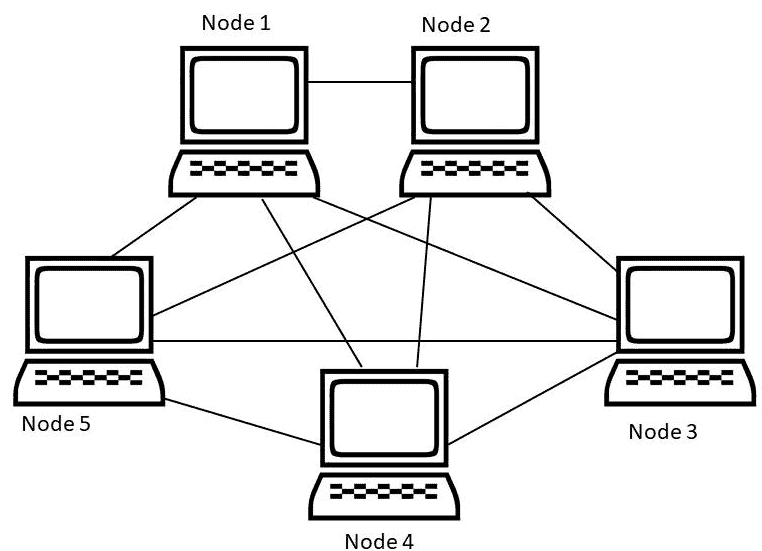
It is one of the most expensive topologies as it requires a lot of cabling work. Mesh topology has a web-like structure of interconnected nodes. Unlike the above-listed topologies, there is no specific route for data transmission. Under this topology, message transmission from the primary source to the final destination can happen through several possible paths as all nodes are connected non-hierarchically. This network topology can be Full or partial mesh. Also, they follow two ways to transmit data – Routing and Flooding. As per the routing, the nodes exercise logic to identify the most efficient and shortest route to reach the packet destination. However, flooding data transmission methods do not exercise any routing logic and transmit data using any medium within the network.
Advantages of Mesh Topology:
- Reliable and Stable system
- Resistant to failures
- Data collision is not possible
- Quick Data Transmission
- Fault in one node will not pause the entire network
- Do not have a central authority
- Adding new devices will not cause any disruption in the data transmission
Disadvantages of Mesh Topology:
- Time Consuming
- Mesh Technology is expensive compared to other topologies as a lot of cabling is needed
- Difficult to set up and maintain
- Sometimes redundant connections are passed when the data is flooded
6. Hybrid Topology
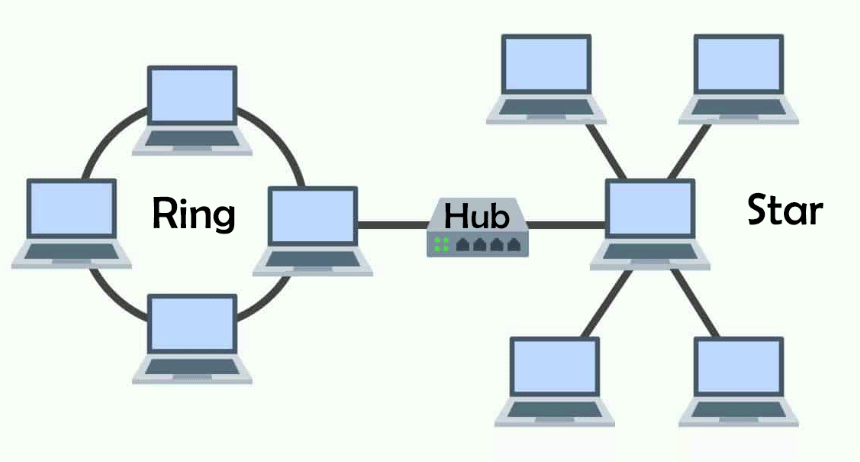
A hybrid topology is a combination of two or more above-listed topologies. Big organizations with different departments often prefer hybrid technology to meet network usage needs. As a result, the network infrastructure is highly flexible and reliable. Let us share an example of hybrid topology – a mix of star-bus and star-ring network configurations.
Advantages of Hybrid Topology:
- Reliable, Flexible, and Scalable
- Modification in the network is possible
- Minimum chances of data loss or collisions
- Unlike other topologies, hybrid topology offers easy detection of faults and troubleshooting
- Can be efficiently designed as per organizational requirements
Disadvantages of Hybrid Topology:
- Highly complex
- Expensive
- Multi-station access units are needed
- Requires professionals to manage the complex network
How to Choose the Right Network Topology
Various factors play a vital role in choosing the suitable topology for your organization. Cable length, type, scalability, size of your business, set up cost are some of the factors that determine which topology is best suitable for you. Almost all topologies require the use of cables (twisted pairs, coaxial cables, and optical fiber cables) to connect one node to the other or hub devices. Thus, the cable installation cost is one of the critical factors to consider when choosing a topology. The more complex topology one chooses for his business, the more he’ll need to spend on the resources and set up installation.
For example, bus topology is the right choice for small network businesses as it is easy to install, cost-effective, and lightweight in nature. Also, the addition and removal of devices under this topology do not cause any disruption.
Similarly, organizations that want to hold large networks and spread into many branches must account for Tree Topology. It is best suitable for university campuses, hospitals, etc.
If you are still getting confused with which topology is best for your network, differentiate the above-listed topologies based on Cable length requirement, type of cable you need, cost, and scalability.
- Cable Length More use of cable implies more time and money required to set up. In this case, opt for bus and star topologies as they are less labor-intensive, lightweight, and easy to install.
- Cable Type Network Topology generally involves three types of cables – Coaxial, fiber-optic cables, and twisted-pair cables. Twisted-pair lines are less costly but have low bandwidth in comparison to coaxial cables. On the other Fiber-optic cables transmit data faster but are expensive to install. So, make a final call, depending on your budget and the type of applications you will be run.
- Cost We have already listed the cost for some of the complex network topologies to help you make the final call. Next, you need to determine how much you are willing to invest in the installation and operating costs.
- Scalability IT teams must also recommend a scalable topology to organizations that plan to expand their network infrastructure in the future. Again, Star topology is the right option for such organizations as there is minimal disruption in adding new nodes.
How Does the Network Topology Mapper in Site24x7 help manage and monitor networks?
Site247’s Network Topology Mapper is an automated system that is fully integrated into the network monitoring unit of the cloud-based platform. This tool installs a data collector on your network and that performs an autodiscovery routine. When the Site24x7 server receives this data, it creates a hardware inventory and map in the console. The routine repeats continuously, keeping the inventory and map constantly up to date. The network monitoring package also includes a network device status scanner and a traffic analyzer. All of these actions are linked together in the system console, so you can hop between different screens of information about your network links and individual devices. The package also provides network troubleshooting tools.
Pros:
- Network discovery that repeats continuously
- Network inventory and topology map are generated automatically
- Simple Network Management Protocol for device performance monitoring
- Flow protocols, such as NetFlow and IPFIX for traffic analysis
- Network configuration management
Cons:
- No on-premises version – only available as a cloud-based SaaS plan
Site24x7 doesn’t just monitor networks. It also watches over endpoints, on-premises software, cloud services, Web applications, and internet connections. The system is suitable for monitoring multiple sites in a WNA and there is also an edition for managed service providers. You can check out the Site24x7 platform with a 30-day free trial.
Final Thoughts
Network Topology is the structural configuration of network devices that may be depicted physically or logically. The best you can do is to figure out the requirement of the network. Accordingly, opt for a complex or straightforward topology for your organization. There are various network topologies, such as Star Topology, Bus Topology, Mesh Topology, Tree Topology, Ring Topology, and Hybrid Topology. Each has its purpose, advantage, and disadvantage. Be it a small, medium, or large enterprise, and you will need a roadmap to run your daily operations smoothly.
There are also exceptionally reliable and scalable network configuration tools that will help generate reports, scan devices automatically, detect any changes made to network topology, monitor and maintain better performance. Before jumping into any final decision related to network topology, try using a network topology mapping tool. I would recommend Site24x7 for any organization as it fulfills regulatory compliance requirements, auto-discover devices, and generates a quality report.

